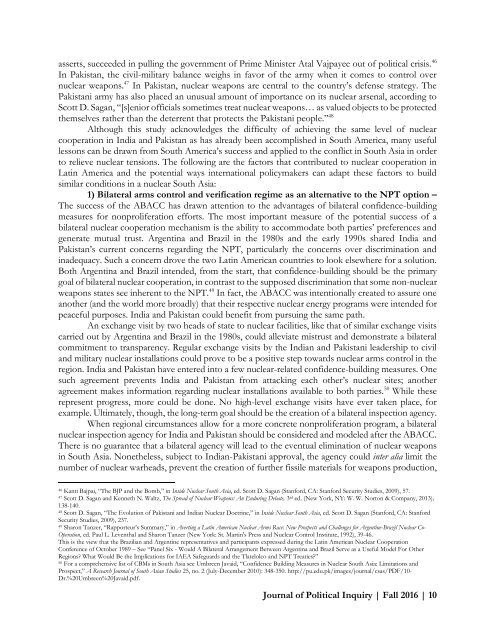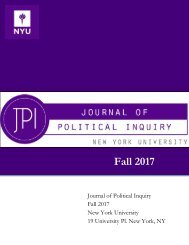Fall2016_Final
Create successful ePaper yourself
Turn your PDF publications into a flip-book with our unique Google optimized e-Paper software.
asserts, succeeded in pulling the government of Prime Minister Atal Vajpayee out of political crisis. 46<br />
In Pakistan, the civil-military balance weighs in favor of the army when it comes to control over<br />
nuclear weapons. 47 In Pakistan, nuclear weapons are central to the country’s defense strategy. The<br />
Pakistani army has also placed an unusual amount of importance on its nuclear arsenal, according to<br />
Scott D. Sagan, “[s]enior officials sometimes treat nuclear weapons… as valued objects to be protected<br />
themselves rather than the deterrent that protects the Pakistani people.” 48<br />
Although this study acknowledges the difficulty of achieving the same level of nuclear<br />
cooperation in India and Pakistan as has already been accomplished in South America, many useful<br />
lessons can be drawn from South America’s success and applied to the conflict in South Asia in order<br />
to relieve nuclear tensions. The following are the factors that contributed to nuclear cooperation in<br />
Latin America and the potential ways international policymakers can adapt these factors to build<br />
similar conditions in a nuclear South Asia:<br />
1) Bilateral arms control and verification regime as an alternative to the NPT option –<br />
The success of the ABACC has drawn attention to the advantages of bilateral confidence-building<br />
measures for nonproliferation efforts. The most important measure of the potential success of a<br />
bilateral nuclear cooperation mechanism is the ability to accommodate both parties’ preferences and<br />
generate mutual trust. Argentina and Brazil in the 1980s and the early 1990s shared India and<br />
Pakistan’s current concerns regarding the NPT, particularly the concerns over discrimination and<br />
inadequacy. Such a concern drove the two Latin American countries to look elsewhere for a solution.<br />
Both Argentina and Brazil intended, from the start, that confidence-building should be the primary<br />
goal of bilateral nuclear cooperation, in contrast to the supposed discrimination that some non-nuclear<br />
weapons states see inherent to the NPT. 49 In fact, the ABACC was intentionally created to assure one<br />
another (and the world more broadly) that their respective nuclear energy programs were intended for<br />
peaceful purposes. India and Pakistan could benefit from pursuing the same path.<br />
An exchange visit by two heads of state to nuclear facilities, like that of similar exchange visits<br />
carried out by Argentina and Brazil in the 1980s, could alleviate mistrust and demonstrate a bilateral<br />
commitment to transparency. Regular exchange visits by the Indian and Pakistani leadership to civil<br />
and military nuclear installations could prove to be a positive step towards nuclear arms control in the<br />
region. India and Pakistan have entered into a few nuclear-related confidence-building measures. One<br />
such agreement prevents India and Pakistan from attacking each other’s nuclear sites; another<br />
agreement makes information regarding nuclear installations available to both parties. 50 While these<br />
represent progress, more could be done. No high-level exchange visits have ever taken place, for<br />
example. Ultimately, though, the long-term goal should be the creation of a bilateral inspection agency.<br />
When regional circumstances allow for a more concrete nonproliferation program, a bilateral<br />
nuclear inspection agency for India and Pakistan should be considered and modeled after the ABACC.<br />
There is no guarantee that a bilateral agency will lead to the eventual elimination of nuclear weapons<br />
in South Asia. Nonetheless, subject to Indian-Pakistani approval, the agency could inter alia limit the<br />
number of nuclear warheads, prevent the creation of further fissile materials for weapons production,<br />
46<br />
Kanti Bajpai, “The BJP and the Bomb,” in Inside Nuclear South Asia, ed. Scott D. Sagan (Stanford, CA: Stanford Security Studies, 2009), 57.<br />
47<br />
Scott D. Sagan and Kenneth N. Waltz, The Spread of Nuclear Weapons: An Enduring Debate, 3 rd ed. (New York, NY: W. W. Norton & Company, 2013),<br />
138-140.<br />
48<br />
Scott D. Sagan, “The Evolution of Pakistani and Indian Nuclear Doctrine,” in Inside Nuclear South Asia, ed. Scott D. Sagan (Stanford, CA: Stanford<br />
Security Studies, 2009), 237.<br />
49<br />
Sharon Tanzer, “Rapporteur’s Summary,” in Averting a Latin American Nuclear Arms Race: New Prospects and Challenges for Argentine-Brazil Nuclear Co-<br />
Operation, ed. Paul L. Leventhal and Sharon Tanzer (New York: St. Martin's Press and Nuclear Control Institute, 1992), 39-46.<br />
This is the view that the Brazilian and Argentine representatives and participants expressed during the Latin American Nuclear Cooperation<br />
Conference of October 1989 – See “Panel Six - Would A Bilateral Arrangement Between Argentina and Brazil Serve as a Useful Model For Other<br />
Regions? What Would Be the Implications for IAEA Safeguards and the Tlatelolco and NPT Treaties?”<br />
50<br />
For a comprehensive list of CBMs in South Asia see Umbreen Javaid, “Confidence Building Measures in Nuclear South Asia: Limitations and<br />
Prospect,” A Research Journal of South Asian Studies 25, no. 2 (July-December 2010): 348-350. http://pu.edu.pk/images/journal/csas/PDF/10-<br />
Dr.%20Umbreen%20Javaid.pdf.<br />
Journal of Political Inquiry | Fall 2016 | 10
















